Throughout history, medieval princesses captivated courts with their elaborate hairstyles that symbolized nobility, power, and divine grace.
The art of royal hairstyling in the Middle Ages was far more than vanity—it represented status, wealth, and adherence to strict social hierarchies that defined the era.
When adorned with crowns, these hairstyles became masterpieces of beauty and engineering, requiring hours of preparation and the skilled hands of dedicated ladies-in-waiting.
This comprehensive guide to 27 Royal Medieval Hairstyles for Princesses with Crowns explores the most stunning and historically significant styles that graced the heads of Europe’s most powerful women.
From intricate braids woven with golden threads to flowing veils secured by jeweled circlets, each hairstyle tells a story of cultural tradition, religious devotion, and feminine elegance.
Whether you’re preparing for a Renaissance fair, planning a medieval-themed wedding, or simply fascinated by historical fashion, these timeless styles offer inspiration that transcends centuries.
Modern interpretations of these regal looks continue to influence bridal fashion, costume design, and haute couture runways around the world.
Discover how medieval princesses transformed their tresses into crowning glories that complemented their royal diadems and secured their place in history.
Contents
- 1 1. The Classic Center-Parted Crown Braid
- 2 2. The Flowing Veil with Jeweled Circlet
- 3 3. The Elaborate Temple Braids with Crown Placement
- 4 4. The Wrapped Coil with Royal Diadem
- 5 5. The Maiden’s Cascade with Floral Crown
- 6 6. The Netted Caul with Circlet Overlay
- 7 7. The Plaited Coronet Style
- 8 8. The Veiled Bun with Tiara Integration
- 9 9. The Horned Hennin Hairstyle
- 10 10. The Rose-Bud Braid Crown
- 11 11. The Side-Swept Cascading Style
- 12 12. The Interwoven Ribbon Crown Braid
- 13 13. The Coiled Serpent with Jeweled Crown
- 14 14. The Half-Up Twisted Crown Style
- 15 15. The Spiral Tower Braids
- 16 16. The Fresh Flower-Studded Style
- 17 17. The Braided Crown with Hanging Lockets
- 18 18. The Pinned Wave Crown Style
- 19 19. The Wrapped Gold Thread Braids
- 20 20. The Lattice Crown Braid
- 21 21. The Draped Veil with Side Braids
- 22 22. The Triple-Tiered Crown Braids
- 23 23. The Asymmetric Braided Crown with Jewel Cascade
- 24 24. The Woven Pearl Crown
- 25 25. The Heraldic Crown Braid
- 26 26. The Moonlight Maiden Crown
- 27 27. The Victory Crown with Laurel Braids
- 28 Conclusion
1. The Classic Center-Parted Crown Braid

The center-parted crown braid represented the epitome of medieval simplicity and elegance, favored by princesses across European kingdoms for both ceremonial occasions and daily court life.
This hairstyle featured hair meticulously divided down the middle and woven into two substantial braids that crowned the head, creating the perfect foundation for royal circlets and tiaras.
Key Characteristics:
- The hair is sectioned precisely down the center from forehead to nape, creating perfect symmetry that medieval aesthetics highly valued
- Each section is braided tightly against the scalp in a Dutch or French braid technique, following the natural curve of the head
- The braids typically meet at the back of the crown, where they can be pinned, coiled, or left to hang as decorative elements
- Ribbons in royal colors—crimson, gold, or royal blue—were often woven through the braids to add dimension and signify family allegiance
- The crown or circlet rests directly on top of the braided structure, which provides stability and prevents the royal headpiece from slipping
Historical Significance:
- This style appeared frequently in 12th and 13th-century illuminated manuscripts depicting royal women at prayer and state functions
- The center part symbolized balance and godliness, virtues expected of medieval noblewomen who served as moral examples
- French and English courts particularly favored this style for young princesses before marriage, representing their virginal purity
Modern Adaptation Tips:
- Use texturizing spray on clean hair to create grip for more secure braiding
- Incorporate small flowers or pearl pins along the braid pathway for romantic embellishment
- Pair with a delicate gold circlet or floral crown for weddings and formal events
2. The Flowing Veil with Jeweled Circlet
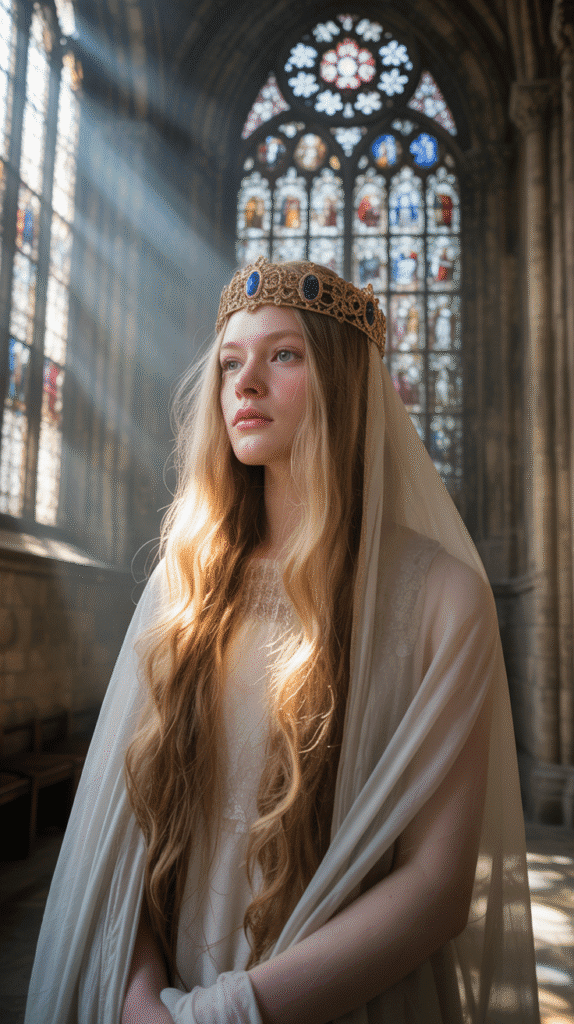
Medieval princesses frequently combined loose, flowing hair with sheer veils held in place by ornate jeweled circlets, creating an ethereal appearance that emphasized youth, purity, and divine favor.
This hairstyle balanced the requirement for modesty with the display of beautiful, healthy hair—considered a woman’s crowning glory.
Construction Elements:
- Hair is brushed until glossy and left to flow naturally down the back, often reaching waist-length or beyond
- A sheer silk or linen veil is draped over the crown of the head, extending down the back to shoulder-blade length or lower
- The jeweled circlet sits atop the veil and hair, positioned approximately one inch back from the hairline
- The circlet’s weight and design secure both veil and hair while making a statement of wealth and status
- Some variations included the veil attached directly to the circlet’s interior band for additional security
Symbolic Meaning:
- Flowing hair signified unmarried status in many medieval cultures, as married women covered their hair completely
- The veil represented modesty and religious devotion, essential qualities for royal women expected to set moral examples
- Jewels in the circlet often held specific meanings—sapphires for wisdom, rubies for passion, pearls for purity
Occasion and Context:
- This style appeared at coronations, royal weddings, and important religious ceremonies where princesses played ceremonial roles
- Portraits of medieval saints and royal brides frequently depicted this combination, cementing its association with sacred femininity
- The style remained popular from the 11th through 14th centuries across Western European courts
3. The Elaborate Temple Braids with Crown Placement
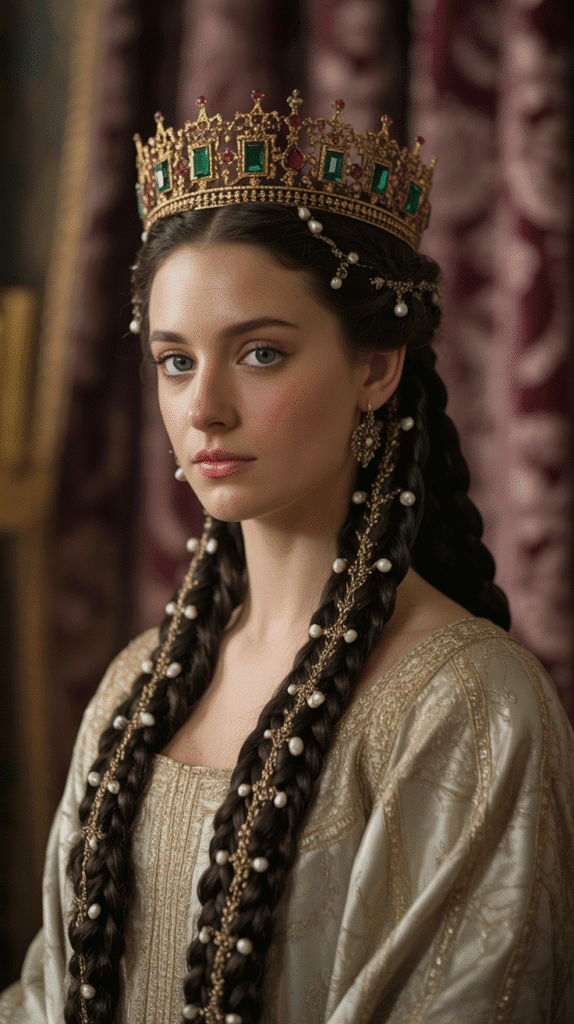
Temple braids created one of the most sophisticated and architecturally complex medieval hairstyles, featuring intricate braiding that framed the face while providing structural support for heavy ceremonial crowns.
This style demonstrated the wearer’s access to skilled attendants and her patience in enduring hours of preparation.
Technical Construction:
- Hair at the temples is sectioned into multiple thin strands, each braided individually using three-strand or four-strand techniques
- These delicate braids are pulled back and secured at the crown, creating a framework that resembles a woven basket
- The remaining hair can be left loose, braided in a single plait, or coiled into elaborate buns at the nape
- Small gold threads, seed pearls, or tiny gemstones are often woven into the braids themselves for added luxury
- The crown sits on top of this braided foundation, with prongs or combs extending into the structure for security
Regional Variations:
- Germanic princesses favored thicker temple braids with metallic threads matching their crown’s metal
- Italian nobility preferred looser, more romantic temple braids incorporating fresh flowers alongside jewels
- Spanish royal courts developed a variation that covered the ears completely with flat, wide temple braids
Practical Advantages:
- The braided structure distributed the crown’s weight more evenly across the scalp, preventing headaches during lengthy ceremonies
- This style kept hair completely away from the face, important for visibility during processionals and public appearances
- The complexity of the style signaled the princess’s high rank and access to numerous skilled attendants
4. The Wrapped Coil with Royal Diadem
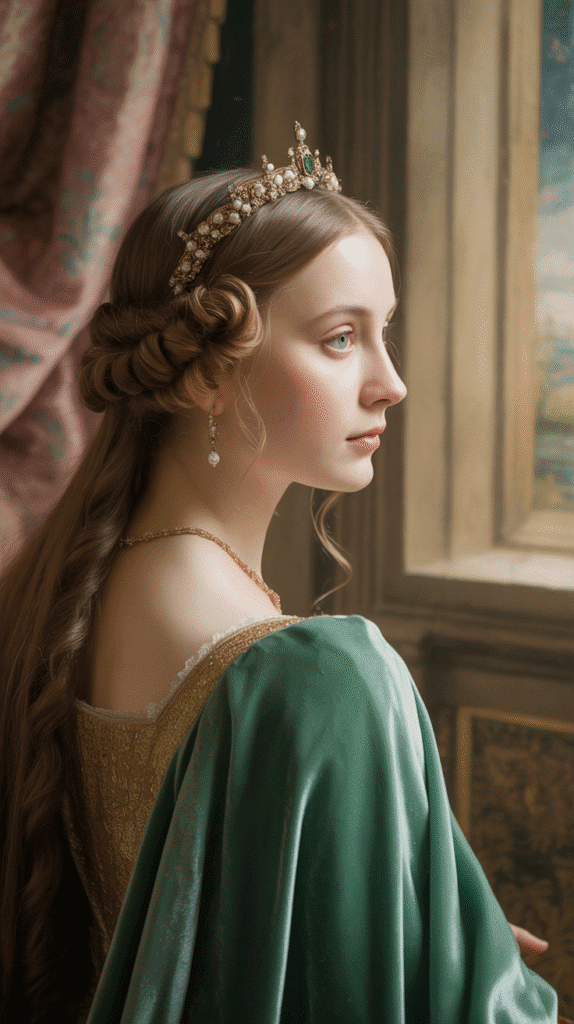
The wrapped coil hairstyle represented medieval sophistication at its finest, featuring hair coiled into elegant shapes at the nape or sides of the head and secured with decorative wrappings before crown placement.
This style appeared most frequently in 14th and 15th-century court portraits of mature princesses and queens.
Styling Process:
- All hair is gathered and divided into sections based on the desired coil placement—single central coil or dual side coils were most common
- Each section is twisted or rope-braided to create a sturdy foundation that holds its shape throughout long court appearances
- The twisted hair is then coiled into a flat spiral or cylindrical bun, pinned securely with long metal hairpins
- Silk ribbons, gold cords, or jeweled bands are wrapped around the coils, both decoratively and to provide additional security
- The diadem or crown is positioned either above the coils or integrated into the wrapped bands themselves
Material Significance:
- Gold cord wrapping indicated the highest royal status and was reserved for princesses of ruling houses
- Silk ribbons in specific colors communicated family allegiances and territorial claims during politically strategic marriages
- Some wrapped coils incorporated actual chains of precious metals as both jewelry and functional securing elements
5. The Maiden’s Cascade with Floral Crown
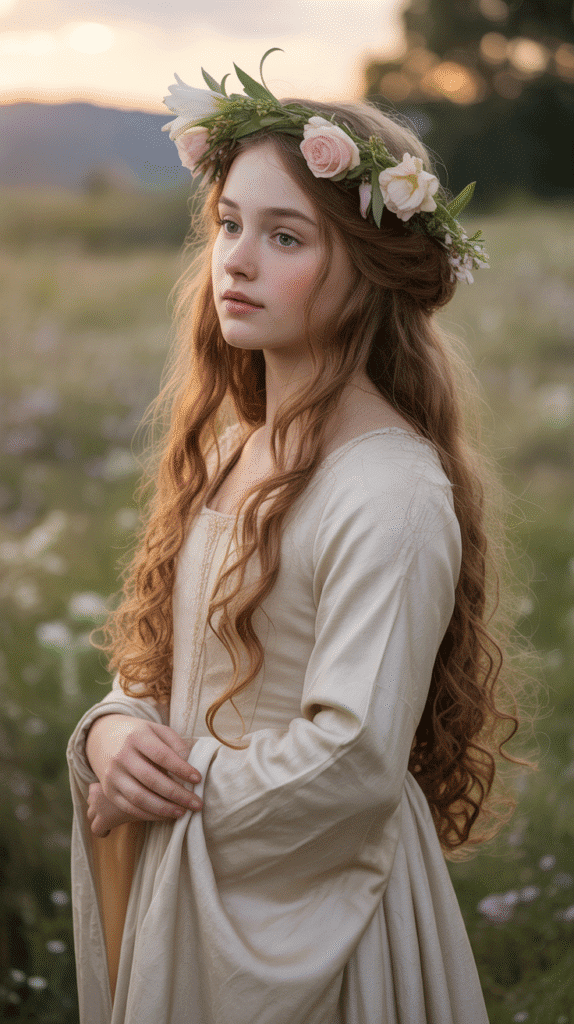
The maiden’s cascade combined the innocence of loose, flowing hair with natural elements, creating a romantic style perfect for young princesses during spring festivals and outdoor celebrations.
This hairstyle emphasized the connection between royalty and nature’s beauty.
Design Features:
- Hair flows freely down the back with minimal styling, showcasing natural texture and healthy shine
- The front sections at the temples are pulled back loosely and secured at the crown with decorative pins
- A wreath-style crown made of fresh flowers, greenery, and sometimes gold or silver wire forms the primary headpiece
- Flowers chosen for the crown held symbolic meanings—roses for love, lilies for purity, forget-me-nots for remembrance
- Ribbons or thin braids could be incorporated into the flowing hair to add structure without sacrificing the natural appearance
Seasonal and Cultural Context:
- This style dominated May Day celebrations and summer solstice festivals where royal families participated in folk traditions
- Young princesses wore this hairstyle during betrothals to emphasize their youth and fertility
- Celtic and Norse-influenced regions particularly embraced floral crowns as connections to pre-Christian traditions
Preservation Techniques:
- Fresh flowers were kept in small water vials hidden within the crown structure to prevent wilting during daylong events
- Some floral crowns featured silk or metal flowers alongside fresh blooms for longevity
- Court gardeners cultivated specific varieties known for maintaining appearance longer after cutting
6. The Netted Caul with Circlet Overlay
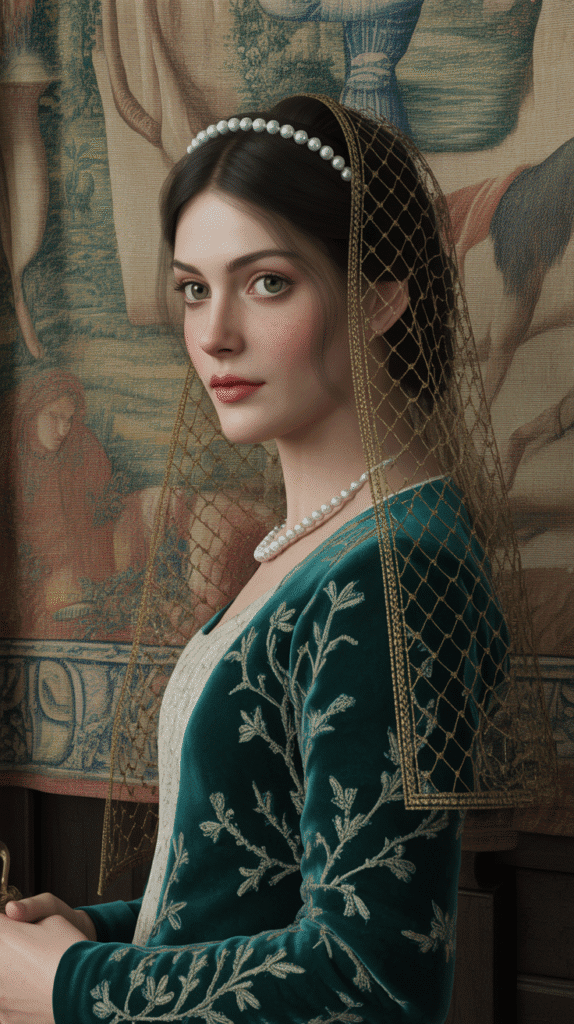
The netted caul represented one of the most distinctive medieval hairstyles, featuring hair contained within decorative nets made of gold thread, silk, or even pearls, topped with elegant circlets.
This style dominated European courts during the 14th and 15th centuries.
Construction Methodology:
- All hair is gathered and coiled low at the nape or divided into two sections at the sides of the head
- The coiled hair is enclosed in a mesh caul—a decorative net that could be simple or extraordinarily elaborate
- Cauls were crafted from various materials: gold or silver thread for the wealthiest, silk cords for lesser nobility
- Some cauls featured gemstones at each intersection of the netting, creating glittering enclosures for the hair
- A circlet or small crown is worn above the caul, with the combination creating a distinctive silhouette
Status Indicators:
- The density and material of the caul directly corresponded to the wearer’s wealth and position
- Royal princesses wore cauls with pearls or precious stones at every junction point
- The technique of caul-making was a specialized craft, with master artisans commanding high fees
Regional Popularity:
- English and Burgundian courts particularly favored this style during the Hundred Years’ War period
- Italian city-states developed versions incorporating local lace-making techniques into caul construction
- French princesses often combined cauls with elaborate henin-style veils for maximum dramatic effect
7. The Plaited Coronet Style
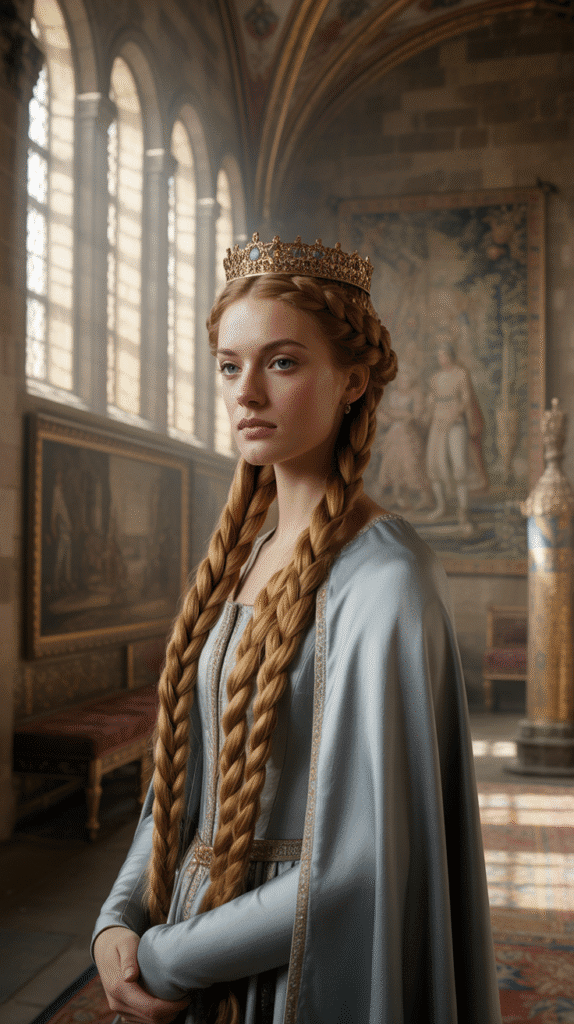
The plaited coronet hairstyle transformed the princess’s own hair into crown-like structures through intricate braiding techniques that circled the head, with actual crowns placed atop or integrated into the braided coronet.
This style demonstrated exceptional hair length and quality.
Braiding Technique:
- Multiple sections of hair are braided separately, typically three to five substantial plaits
- These braids are wrapped around the head in layers, creating a raised, crown-like structure
- Each braid is pinned securely to the one beneath it, building height and stability
- The braids can incorporate ribbons, chains, or decorative cords between layers for added visual interest
- The actual crown sits on top of this braided foundation or has pins that secure into the plaited structure
Hair Length Requirements:
- This style required exceptionally long hair, typically past waist-length, to create the necessary volume
- Medieval women rarely cut their hair, making such length common among nobility who had access to proper nutrition
- Extensions made from horsehair or purchased human hair could be added for those with insufficient natural length
Advantages and Symbolism:
- The style kept all hair neatly contained while creating impressive height and presence
- Creating a crown from one’s own hair symbolized inherent royalty and divine right to rule
- The complexity ensured the style lasted multiple days without needing complete reconstruction
8. The Veiled Bun with Tiara Integration
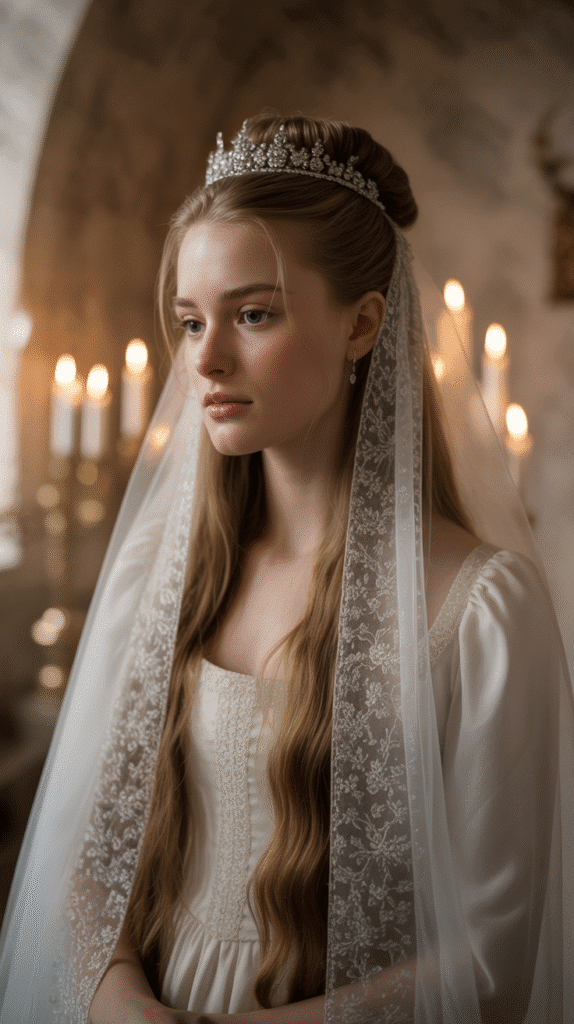
Combining modesty with magnificence, the veiled bun hairstyle featured hair coiled into elegant buns at the crown or nape and covered with transparent or decorative veils that were secured by integrated tiaras.
This style suited both young and mature princesses for formal occasions.
Structural Elements:
- Hair is smoothed with perfumed oils or pomades to create a sleek base before styling
- The hair is gathered into one or two buns positioned strategically for crown placement
- A fine veil of silk, linen, or gauze is draped over the bun(s) and pinned discreetly
- The tiara features extended prongs or a comb base that pierces through veil and bun for security
- Some versions included the veil attached permanently to the tiara’s back edge, creating a unified piece
Veil Variations:
- Transparent veils allowed glimpses of the hair’s color and the bun’s shape while maintaining modesty standards
- Embroidered veils featured gold threadwork in patterns matching the tiara’s design
- Some royal houses used veils in family colors, making the princess’s lineage immediately identifiable
Ceremonial Usage:
- This style appeared frequently at weddings where the princess transitioned from maiden to wife
- Religious ceremonies required head covering, making this style appropriate while still allowing crown display
- Official portraits often featured this combination to convey both piety and royal authority
9. The Horned Hennin Hairstyle
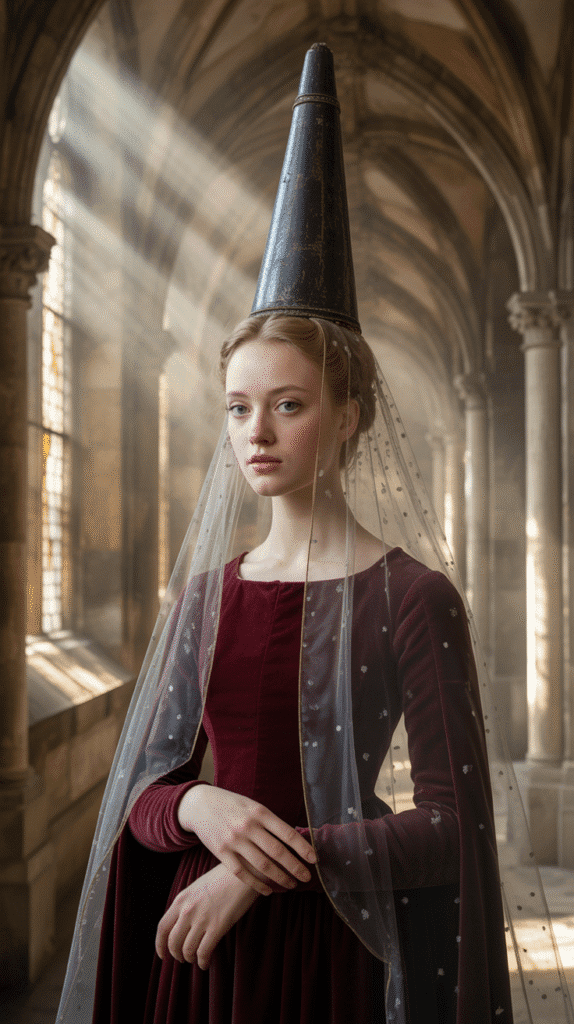
The horned hennin represents one of the most dramatic and recognizable medieval styles, featuring cone-shaped structures that extended upward from the head, often with flowing veils and integrated crowns or circlets at the base.
This bold style dominated Burgundian courts in the 15th century.
Construction Process:
- The hair is tightly braided or coiled close to the scalp and secured with numerous pins
- A stiffened structure made of wire, buckram, or shaped metal forms the cone or horn shapes
- These structures are attached to a cap or band that fits securely on the head
- The hair’s surface braids or coils are sometimes visible at the base, decoratively arranged
- Veils of gossamer silk or gauze are attached to the hennin’s point and flow down dramatically
Cultural Impact:
- The hennin became synonymous with medieval nobility and appears in countless fairy tale illustrations
- Religious authorities sometimes criticized the style as vain and excessive, leading to periodic bans
- The height of the hennin directly correlated with the wearer’s social status—taller meant higher rank
10. The Rose-Bud Braid Crown
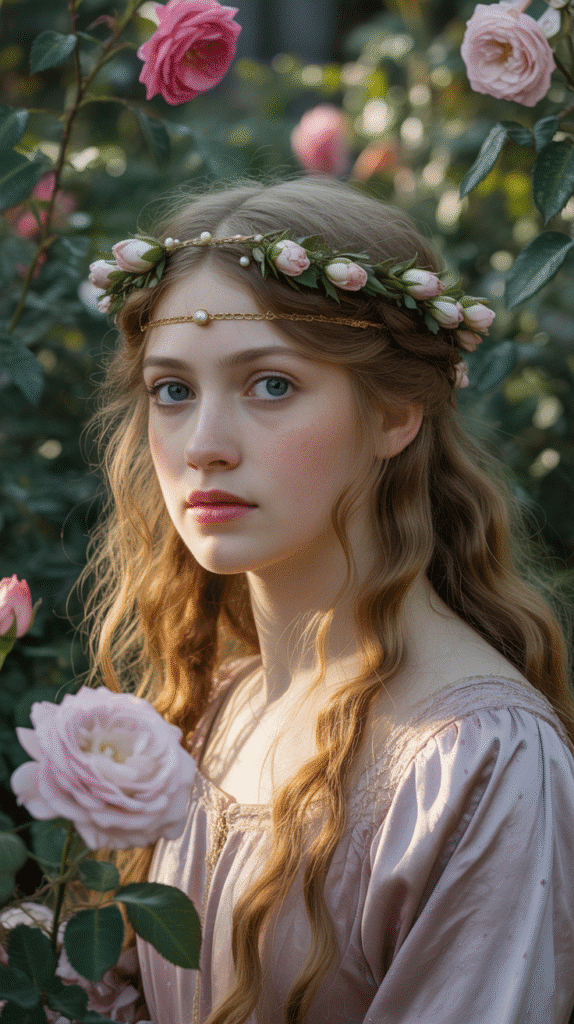
The rose-bud braid crown transformed traditional braiding into three-dimensional floral shapes, creating the illusion of roses formed entirely from hair.
This romantic and technically challenging style suited garden parties and spring celebrations.
Creation Technique:
- Hair is divided into multiple sections, typically six to twelve depending on hair thickness and desired rose size
- Each section is braided tightly, then the braid is rolled into a spiral that resembles a rose bloom
- These “roses” are pinned to the head in a circular pattern, creating a crown-like arrangement
- The center of each rose can be adorned with small pearls or jewels to simulate dewdrops
- A delicate circlet or thin crown is placed over the rose-bud arrangement for added royal distinction
Skill Requirements:
- This style required exceptional expertise from ladies-in-waiting, often taking two to three hours to complete
- The braids needed precise tension—too tight and the roses looked artificial, too loose and they unraveled
- Matching the size of each rose required mathematical division of hair and consistent braiding technique
Symbolic Associations:
- Roses symbolized love, beauty, and the Virgin Mary in medieval culture, making this style particularly meaningful
- Red-haired princesses wore this style to emphasize their natural coloring’s association with passion and vitality
- The style appeared frequently in May Day celebrations and courtly love rituals
11. The Side-Swept Cascading Style
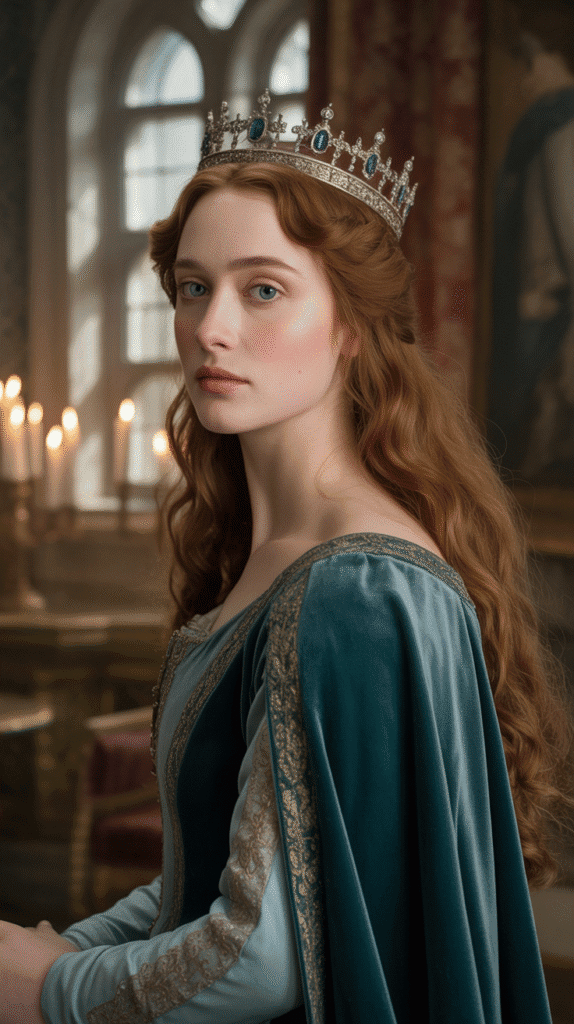
The side-swept cascade offered an asymmetrical alternative to traditional centered styles, featuring hair dramatically swept to one side and flowing over the shoulder.
This elegant style created a romantic, approachable appearance while maintaining royal dignity.
Styling Approach:
- All hair is gathered to one side of the head, typically the right side following court protocol
- The upper section is secured with decorative pins or small braids that blend into the main cascade
- Hair flows over the shoulder in loose waves or gentle curls created through braiding and heat-free setting
- A crown or tiara is positioned asymmetrically, tilted to complement the hair’s directional flow
- Ribbons or pearl strands can be woven through the cascade for added shimmer and movement
Court Protocol Considerations:
- The direction of the sweep sometimes indicated political allegiances or mourning periods
- Princesses seated at the king’s right hand swept hair to the left to avoid interfering with their sovereign
- Some courts required symmetric styles for official portraits but allowed asymmetry for informal settings
Practical Benefits:
- This style showcased particularly beautiful hair or expensive hair ornaments more effectively than centered styles
- The forward placement allowed the princess to see and admire her own hair during long events
- Arranging hair to one side made crown placement easier and more secure with fewer pins required
12. The Interwoven Ribbon Crown Braid
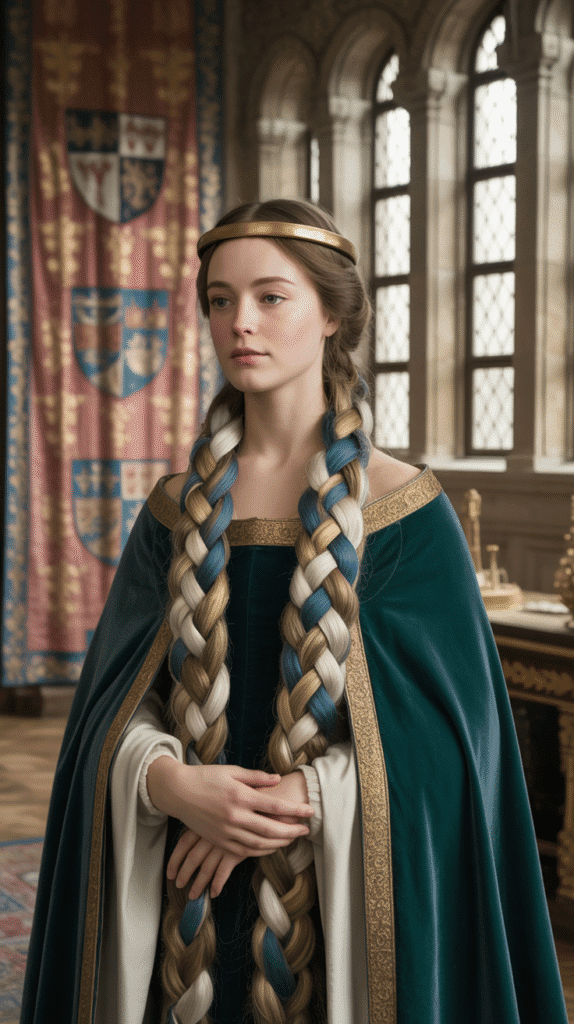
The interwoven ribbon crown braid elevated simple braiding to art form by incorporating multiple colored ribbons that created complex patterns within the braided structure.
This style allowed princesses to display family colors or mark special occasions through ribbon selection.
Weaving Methodology:
- Three to five ribbons in varying colors are selected based on symbolism and occasion
- Hair is divided into sections matching the number of ribbons plus hair strands
- Ribbons and hair are braided together using techniques that showcase ribbon colors in patterns—checkerboard, spiral, or striped
- The completed braid is wrapped around the head in a crown formation and pinned securely
- A minimal circlet or jeweled pins accent the braid without overwhelming the ribbon artistry
Historical Documentation:
- Account books from medieval courts list enormous quantities of silk ribbons purchased specifically for hairstyling purposes
- Illuminated manuscripts show princesses with clearly visible ribbon patterns woven through their hair
- The tradition influenced later centuries, with Renaissance and Baroque styles continuing ribbon incorporation
13. The Coiled Serpent with Jeweled Crown
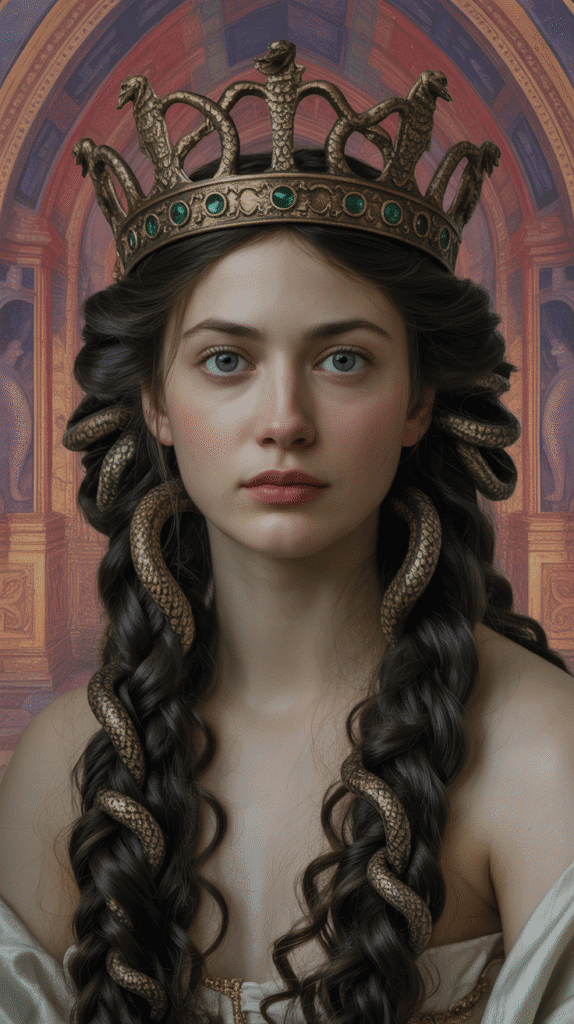
The coiled serpent hairstyle drew inspiration from ancient symbols of wisdom and power, featuring hair arranged in deliberate coils that resembled serpent bodies, topped with crowns bearing serpent motifs.
This dramatic style suited powerful princesses known for intelligence and political acumen.
Coiling Technique:
- Hair is divided into thick sections and each is rope-braided to create firm, tubular shapes
- These rope braids are coiled around the head in patterns that suggest serpent movement
- Coils overlap and interweave, creating three-dimensional sculpture from hair
- The ends are tucked invisibly or left to hang as deliberate serpent “tails”
- Crowns featuring serpent designs—scales, heads, or full serpent forms—complement the hairstyle’s theme
Symbolic Significance:
- Serpents symbolized wisdom, healing, and regeneration in medieval bestiaries and religious texts
- Unlike later Christian interpretations, early medieval culture maintained positive serpent associations from classical antiquity
- Princesses known for learning, medical knowledge, or diplomatic skill particularly favored this style
Regional Variations:
- Byzantine-influenced courts created more literal serpent shapes with visible head and tail formations
- Northern European versions emphasized the coiling pattern over realistic serpent imagery
- Some Italian courts paired this hairstyle with clothing embroidered with serpent motifs for unified symbolic impact
14. The Half-Up Twisted Crown Style
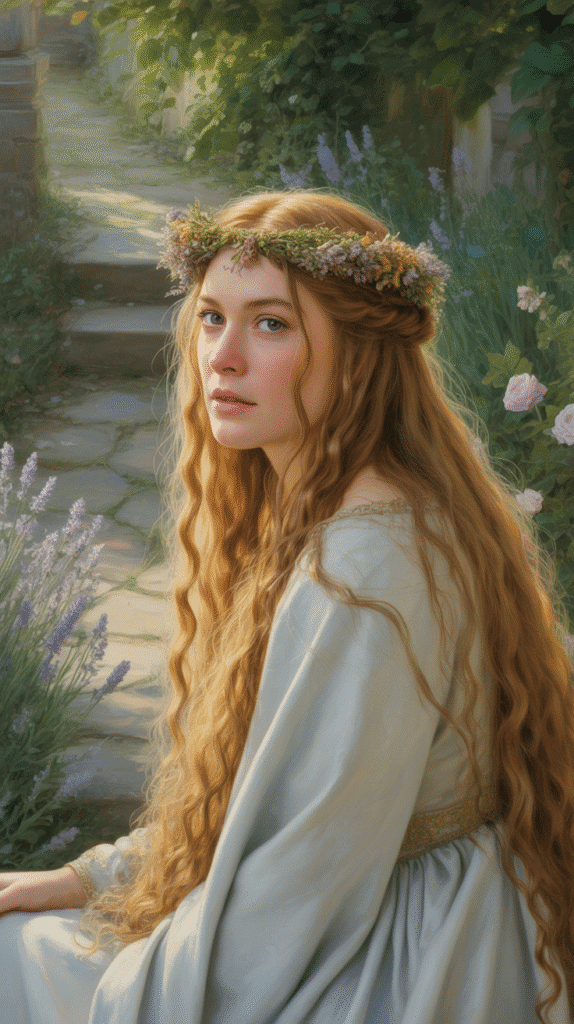
The half-up twisted crown offered versatility by securing the upper portion of hair while allowing lower sections to flow freely.
This balanced style suited both formal ceremonies and more relaxed court gatherings.
Construction Details:
- The top half of hair from temples to crown is sectioned off from the lower portion
- This upper section is twisted rope-style or braided, then wrapped around the head like a natural crown
- The twisted section is secured with pins, creating a stable base for crown placement
- Lower hair flows freely down the back, often styled in loose waves or left naturally straight
- The crown or circlet rests directly on the twisted section, held securely by the hair’s structure
Versatility Factors:
- This style worked for various hair lengths, requiring only shoulder-length or longer hair
- The flowing lower section could be quickly braided if activities required more secure styling
- Princesses could display both hair length (a beauty standard) and neat upper styling simultaneously
Practical Applications:
- Ideal for hunting parties where hair needed partial containment but the princess wanted to display her tresses
- Suitable for warm weather as it kept hair off the neck while maintaining regal appearance
- Young princesses learning hairstyling could more easily manage this style independently
15. The Spiral Tower Braids
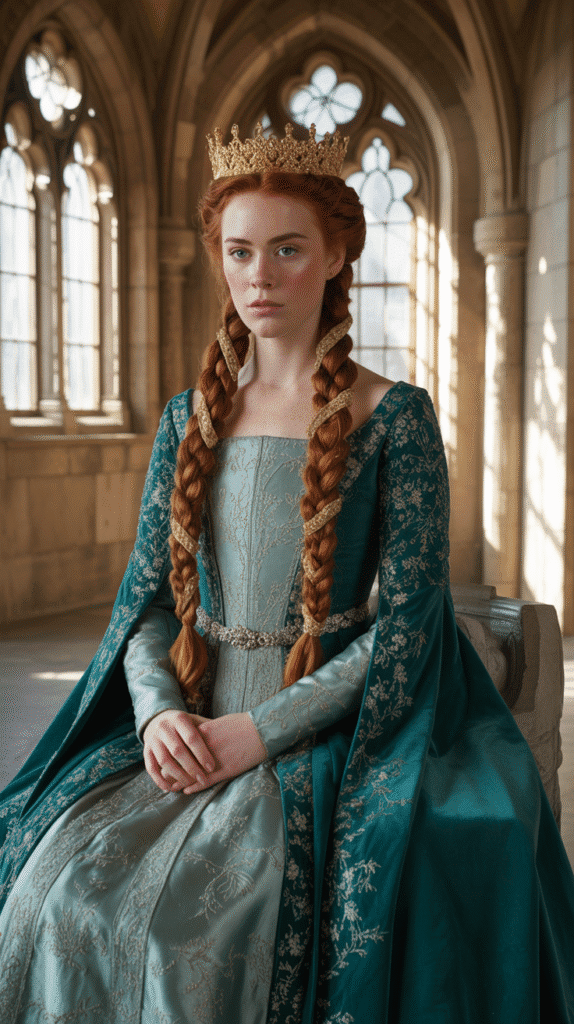
The spiral tower braid style created vertical height through braids wrapped in ascending spirals around support structures, resulting in dramatic tower-like formations that supported the most elaborate crowns.
This architectural hairstyle showcased medieval innovation in structural design.
Engineering Approach:
- Supportive structures made from shaped wire or wooden forms provided the foundation for hair wrapping
- Hair was divided into long sections, each braided and then wrapped spirally around its designated tower form
- Multiple towers (typically two or three) were positioned on the head strategically for balance
- The spaces between towers could feature smaller decorative braids or jeweled chains
- Crowns were designed specifically to rest atop or between the tower structures
Historical Context:
- This style reached peak popularity in the late 14th and early 15th centuries in Burgundian and French courts
- The height of the towers became competitive among noblewomen, leading to increasingly elaborate constructions
- Some towers reached heights of 12-18 inches, requiring the princess to duck through standard doorways
Maintenance Challenges:
- These elaborate structures remained in place for several days, requiring sleeping on special neck-supporting pillows
- Ladies-in-waiting performed daily maintenance, adding fresh wrappings and adjusting pins
- The weight required princesses to develop strong neck muscles and excellent posture
16. The Fresh Flower-Studded Style
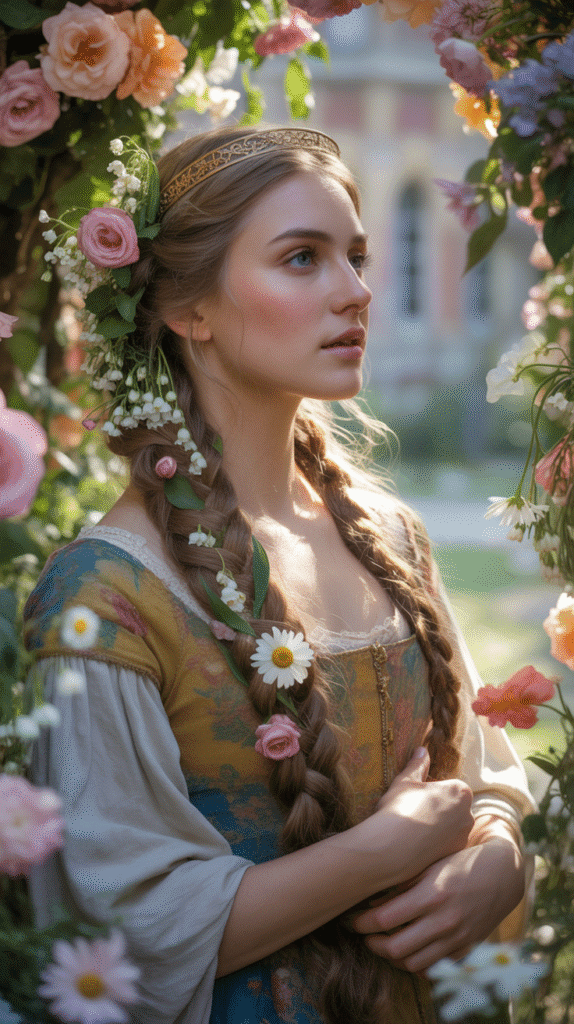
The fresh flower-studded hairstyle incorporated actual blooms throughout the hair arrangement, creating living crowns that changed with seasons and occasions.
This natural approach to royal hairstyling connected princesses to the land and its bounty.
Flower Integration:
- Flowers with sturdy stems were inserted directly into braids, twists, and coils throughout the hairstyle
- Blooms were selected for color coordination with gowns and symbolic meanings appropriate to the occasion
- Small wire or thread loops woven into the hair provided attachment points that protected flower stems
- The base hairstyle typically featured multiple braids or twists that created pockets for secure flower placement
- Metal crowns or circlets incorporated open designs that allowed flowers to weave through the metalwork
Seasonal Variations:
- Spring styles featured delicate blooms like primrose, violets, and early roses in pastel colors
- Summer arrangements used bold flowers like peonies, lilies, and full-bloom roses for dramatic impact
- Autumn styles incorporated wheat stalks, small chrysanthemums, and berry-bearing branches
- Winter required dried flowers, evergreen sprigs, or holly with berries for the few cold-weather celebrations
Preservation Efforts:
- Court herbalists developed techniques to extend flower freshness, including stem treatments and hidden water sources
- Some flowers were partially dried to maintain appearance longer while reducing wilting
- Backup flowers were kept ready for events lasting multiple hours, allowing ladies-in-waiting to refresh arrangements
17. The Braided Crown with Hanging Lockets
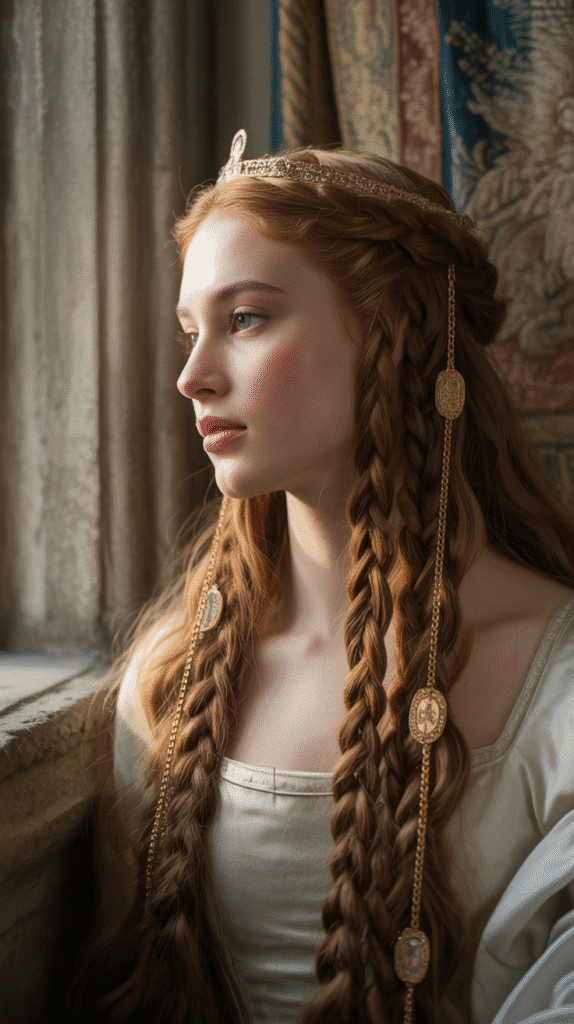
The braided crown with hanging lockets combined structural hairstyling with meaningful jewelry, featuring braids formed into crowns with delicate chains and lockets suspended at intervals.
This personal style allowed princesses to carry portraits, relics, or herbs in decorative containers integrated into their hair.
Design Integration:
- A substantial braid or multiple braids are arranged in a crown formation around the head
- Small loops or attachment points are created within the braid at regular intervals
- Delicate gold or silver chains connect to these points, hanging lockets at various lengths
- The lockets themselves could be functional (holding portraits or relics) or purely decorative
- A circlet or small crown is positioned above the braided crown, with the lockets hanging below
Locket Contents and Meanings:
- Miniature portraits of deceased loved ones kept their memory present during important events
- Religious relics or saint depictions reflected the princess’s devotion and sought divine protection
- Herbs like lavender or rosemary provided pleasant scents and were believed to offer protective properties
- Love tokens from suitors or spouses were displayed during celebrations of romance
Technical Considerations:
- The weight of multiple lockets required exceptionally secure braiding and pinning techniques
- Chain lengths were calculated carefully to prevent tangling during movement
- Ladies-in-waiting learned specialized skills for opening and closing locket fastenings within the hairstyle
18. The Pinned Wave Crown Style
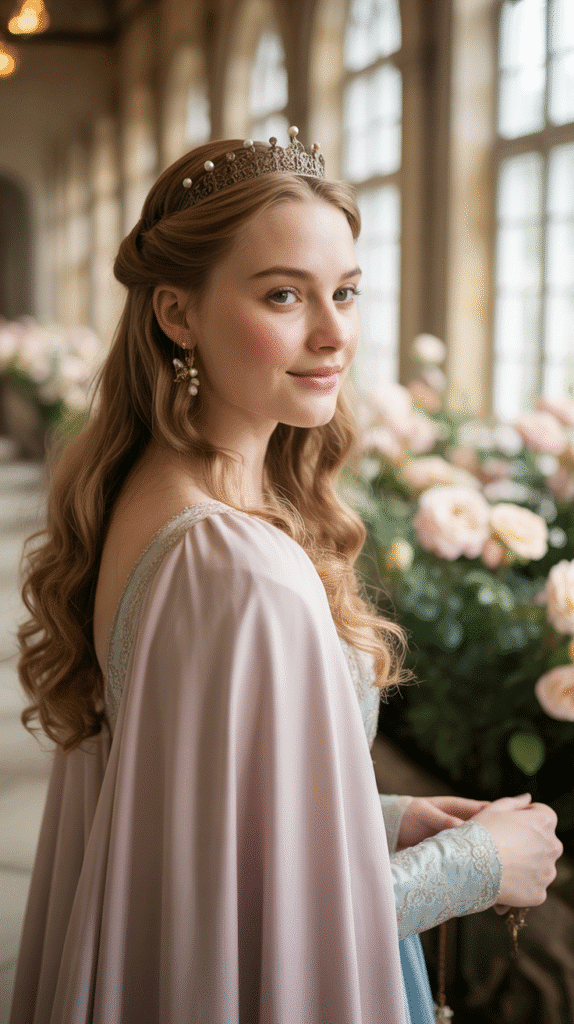
The pinned wave crown created the illusion of natural waves forming a crown-like structure through strategic pinning and setting techniques.
This softer approach to crown hairstyles offered romantic elegance without the severity of tight braiding.
Wave Creation Process:
- Damp hair was braided overnight or set in rags to create wave patterns
- Once dry, braids or rags were removed, leaving defined waves throughout the hair
- The front and side sections of wavy hair were lifted and pinned in arching patterns around the head
- Each wave crest was secured with decorative pins, often featuring pearls or small gemstones
- The crown rested on top of the pinned waves, which provided cushioning and lift
Pin Selection and Decoration:
- Pins ranged from simple metal to elaborate jeweled pieces that became focal points themselves
- Sets of matching pins created visual rhythm around the pinned wave crown
- Some pins featured family crests or heraldic symbols, adding political significance to the hairstyle
- The visibility of pins made them important accessories, with wealthy princesses owning extensive collections
Advantages Over Tight Styles:
- Pinned waves created less tension on the scalp, allowing for longer comfortable wear
- The softer appearance was considered more youthful and romantic
- Hair health improved with less stress from constant tight braiding
- The style could be partially adjusted or refreshed more easily than braided styles
19. The Wrapped Gold Thread Braids
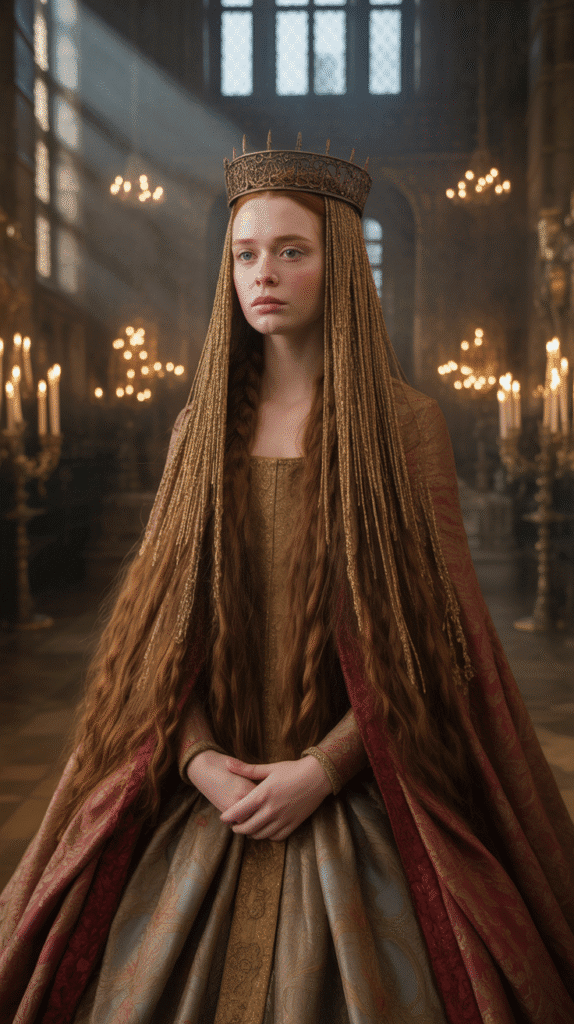
The wrapped gold thread braid style represented the ultimate display of wealth, featuring braids completely wrapped in actual gold thread that caught and reflected light with every movement.
This luxurious style appeared at the most important state occasions and dynastic celebrations.
Gold Wrapping Technique:
- Hair was braided tightly to create a firm foundation for thread wrapping
- Real gold thread (or gold-plated silver for lesser nobility) was wrapped spirally around each braid
- The wrapping proceeded from root to tip, with thread overlapping slightly to ensure complete coverage
- Ends were secured with tiny gold clasps or sewn invisibly into the braid
- Multiple wrapped braids were then arranged into crown formations or other regal styles
Economic Significance:
- The amount of gold thread used indicated the princess’s family wealth and political importance
- Account records show that some royal hairstyles incorporated gold thread worth modern equivalents of thousands of dollars
- The reusable thread was carefully unwound after events and stored in special containers for future use
Visual Impact:
- Candlelight and torchlight in medieval halls made gold-wrapped hair appear luminous and almost supernatural
- The reflective quality created the impression of a halo, associating the princess with divine favor
- Movement caused shifting light patterns that drew attention and created memorable visual impressions
20. The Lattice Crown Braid
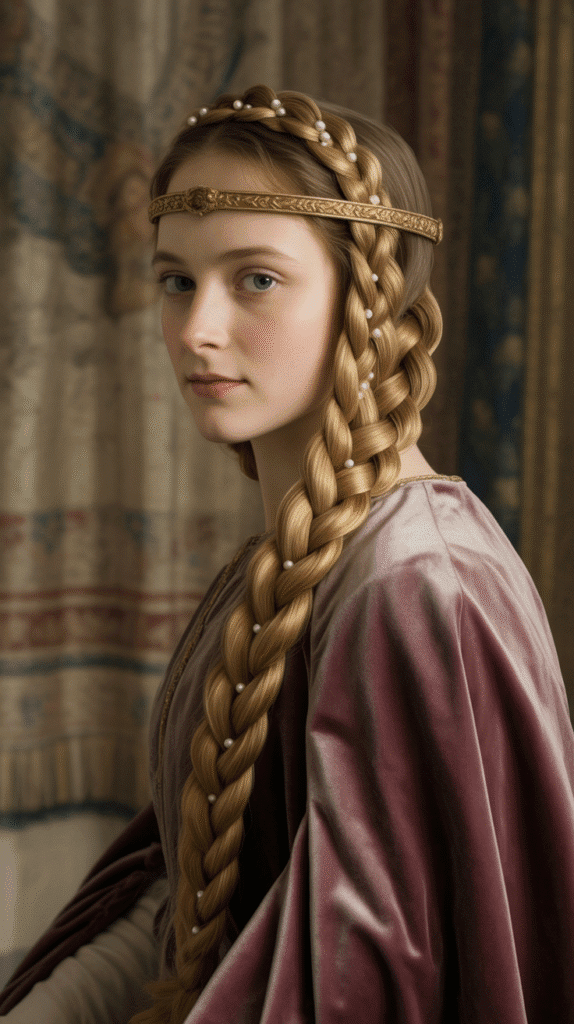
The lattice crown braid created geometric patterns through strategic crossing and weaving of multiple braids, resembling decorative lattice work in architecture and jewelry design.
This mathematical approach to hairstyling demonstrated precision and planning.
Lattice Construction:
- Hair was divided into multiple thin sections, typically six to twelve depending on desired pattern complexity
- Each section was braided individually, creating uniform strands for lattice work
- Braids were laid across each other in over-under patterns, forming diamond, square, or hexagonal openings
- The lattice was secured at each intersection point with small pins or sewn with thread
- The completed lattice wrapped around the head, with a crown positioned on top or woven into the design
Pattern Variations:
- Simple lattice used four to six braids in basic over-under weaving
- Complex lattice incorporated eight or more braids in intricate geometric patterns
- Some versions left the lattice openings visible, creating interesting negative space
- Others filled lattice openings with flowers, jewels, or contrasting ribbon
Skill and Planning Requirements:
- Creating even lattice patterns required mathematical planning of braid thickness and spacing
- Ladies-in-waiting practiced lattice techniques on mannequin heads before attempting royal hair
- The most complex patterns required sketches and planning sessions before execution
21. The Draped Veil with Side Braids
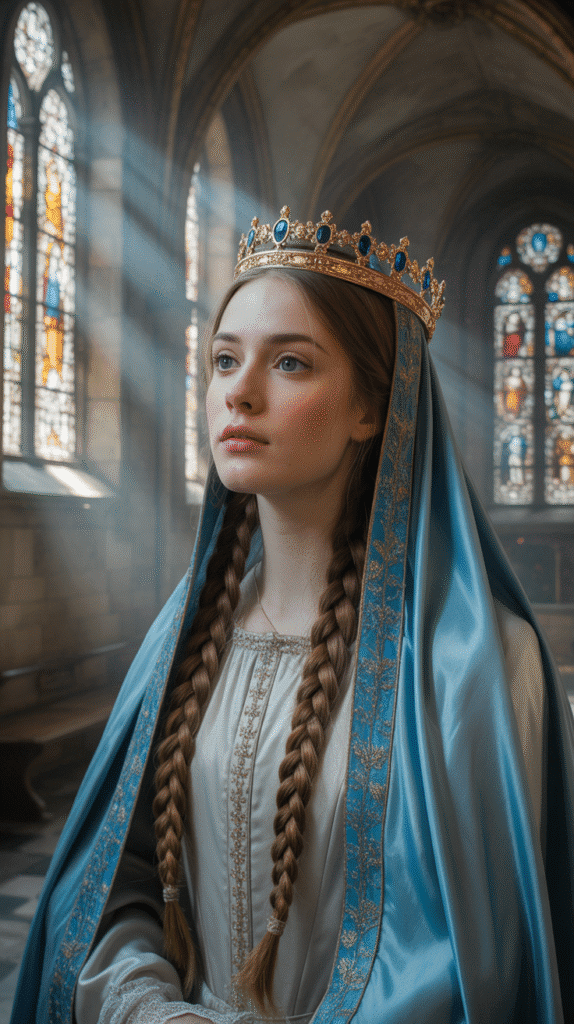
The draped veil with side braids combined the modesty of covered hair with decorative visible braiding, creating an elegant compromise between religious requirements and aesthetic beauty.
This style allowed princesses to display their hairstyling artistry while adhering to codes of propriety.
Layered Construction:
- Two substantial braids were created from hair at the temples and sides of the face
- These side braids were left visible, often incorporating ribbons or gold thread
- The remainder of the hair was covered with a draped veil that fell from the crown of the head
- The veil’s front edge was positioned to showcase the side braids while covering all other hair
- A crown or circlet secured the veil and rested partially on the visible braids
- The visible braids provided enough ornamental interest for court functions without appearing immodest
- Different regions had varying standards for how much hair could remain visible under veils
Veil Fabric Choices:
- Silk veils in jewel tones complemented the visible braids and indicated high status
- White or cream linen veils appeared at religious ceremonies and demonstrated purity
- Embroidered veils featured patterns that coordinated with braid decorations for unified aesthetics
- Transparent veils allowed glimpses of the covered hair while technically fulfilling modesty requirements
Occasions and Context:
- Married princesses adopted this style to distinguish themselves from unmarried maidens with uncovered hair
- Church attendance required this level of coverage in most medieval European regions
- The style appeared frequently in devotional manuscripts showing royal women at prayer
22. The Triple-Tiered Crown Braids
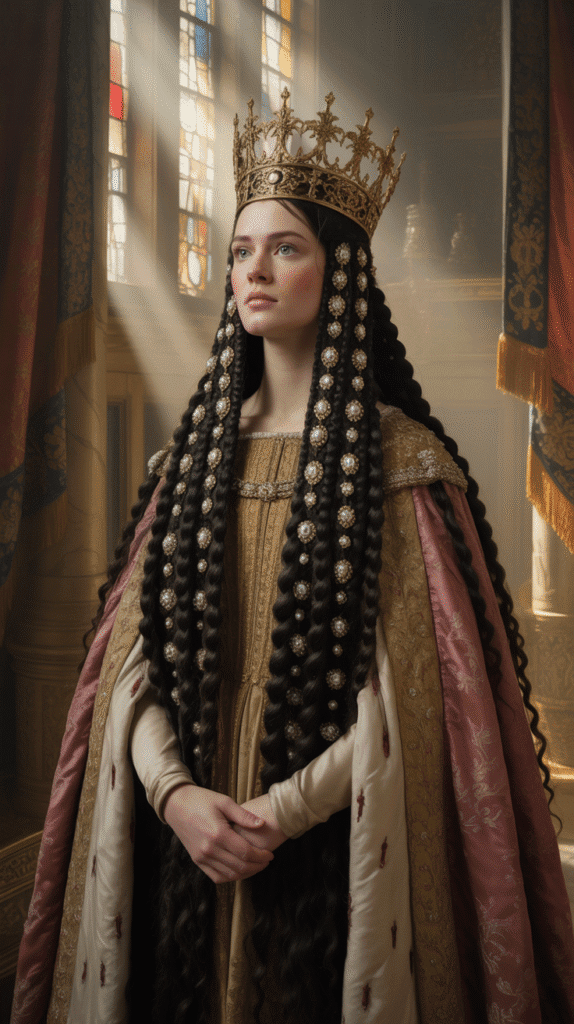
The triple-tiered crown braid created a stepped pyramid effect with three levels of braided crowns stacked on top of each other.
This architectural achievement in hairstyling provided maximum height and drama while offering unparalleled support for heavy ceremonial crowns.
Tiered Construction Method:
- Hair was divided into three horizontal sections from nape to crown
- The bottom tier was braided and wrapped around the head at the lowest level
- The middle tier was braided and secured on top of the first, creating a second ring
- The top tier completed the structure, forming the smallest circumference at the crown
- Each tier was slightly smaller in diameter than the one below, creating a stepped appearance
- The crown was positioned on the top tier, with its base supported by the entire structure
Engineering Advantages:
- The tiered structure distributed crown weight across three levels instead of one point
- The graduated sizing created natural stability that prevented tipping or shifting
- Height was achieved without requiring uncomfortable vertical extensions or frames
- The three-tier system allowed for more elaborate crown designs that would be too heavy for single-level styles
Decorative Variations:
- Each tier could be wrapped in different colored ribbons to create horizontal stripes
- Jewels or flowers could be placed between tiers to emphasize the layered structure
- Some versions featured each tier braided in different patterns—three-strand, four-strand, and rope braids
Historical Prominence:
- This style appeared in coronation ceremonies where crown weight was substantial
- Royal portraits from the 13th and 14th centuries frequently depicted triple-tiered arrangements
- The style became associated with the most solemn and important state occasions
23. The Asymmetric Braided Crown with Jewel Cascade
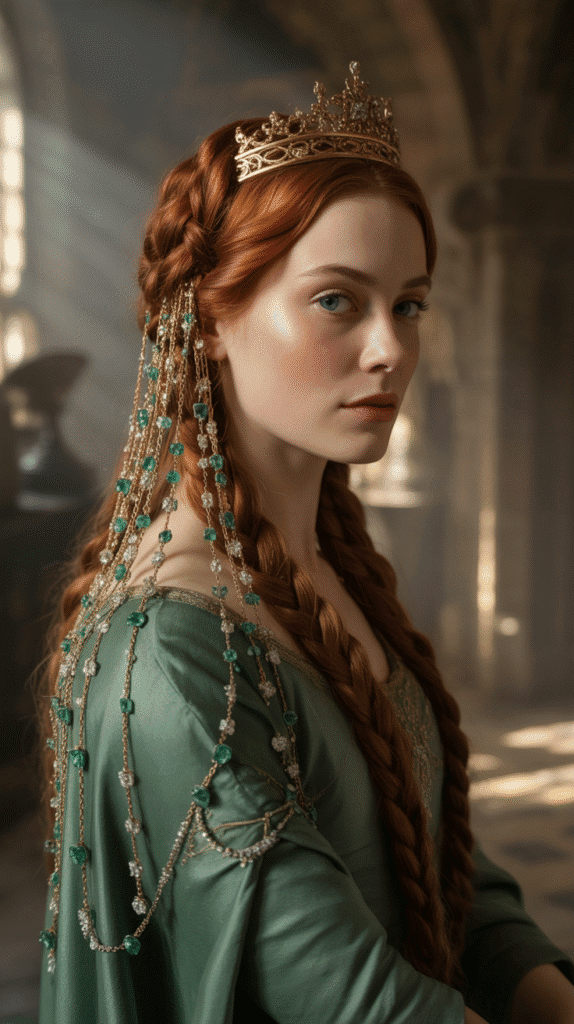
The asymmetric braided crown broke from traditional symmetry by featuring an off-center braid crown from which jeweled chains cascaded down one side.
This bold style suited confident princesses who set trends rather than followed them.
Asymmetric Design:
- A substantial braid began at one temple and wrapped around the head in an off-center spiral
- The braid’s path created intentional asymmetry, with more coverage on one side than the other
- At the point where the braid ended, jeweled chains were attached
- These chains cascaded down over the shoulder, sometimes reaching waist-length
- The crown was positioned at the asymmetric focal point where the braid ended and chains began
Jeweled Chain Details:
- Chains featured gemstones in graduated sizes, with the largest stones positioned near the attachment point
- Multiple chains of varying lengths created a waterfall effect
- The chains’ movement added dynamic visual interest as the princess moved
- Some versions included tiny bells on the chains that created soft musical sounds
Fashion Innovation:
- This style challenged medieval conventions of symmetry and balance in royal appearance
- Younger princesses adopted asymmetric styles to distinguish themselves from older, more conservative royal women
- The style influenced jewelry design, with asymmetric necklaces and earrings becoming fashionable
24. The Woven Pearl Crown
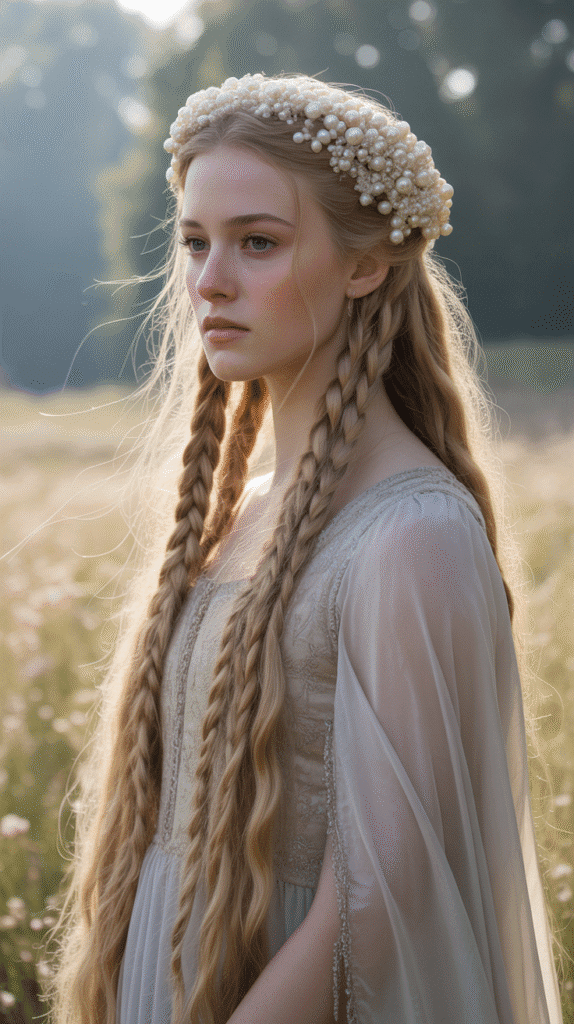
The woven pearl crown style integrated actual pearls directly into the hair structure through specialized weaving techniques, creating a crown entirely from hair and pearls without metal components.
This delicate and expensive style represented the ultimate fusion of natural beauty and luxury.
Pearl Integration Technique:
- Hair was braided in multiple thin strands that would form the crown’s structure
- Pearls were drilled (if not already prepared) and threaded onto fine silk cords
- These pearl-strung cords were woven through and between the hair braids during construction
- The weaving created a fabric-like structure of alternating hair and pearls
- The completed woven piece was shaped into a crown and secured with nearly invisible pins
Pearl Selection and Symbolism:
- Only the most perfectly matched pearls in size and luster were selected for royal hair crowns
- Pearl color choices conveyed meanings—white for purity, pink for youth, black pearls for wisdom
- The number of pearls used indicated wealth, with some crowns incorporating hundreds of individual pearls
- Family pearl collections were specifically maintained for hairstyling purposes across generations
Maintenance and Care:
- Pearls required special care to prevent damage from hair oils and environmental exposure
- After wearing, pearls were carefully removed and cleaned with soft cloths
- Some wealthy families employed specialists solely to maintain their pearl collections
Value and Inheritance:
- Pearl crown styles represented significant financial investments, often included in dowry negotiations
- Specific pearl collections were named and documented in family records
- Heirloom pearls carried family history and were worn at important dynastic moments
25. The Heraldic Crown Braid
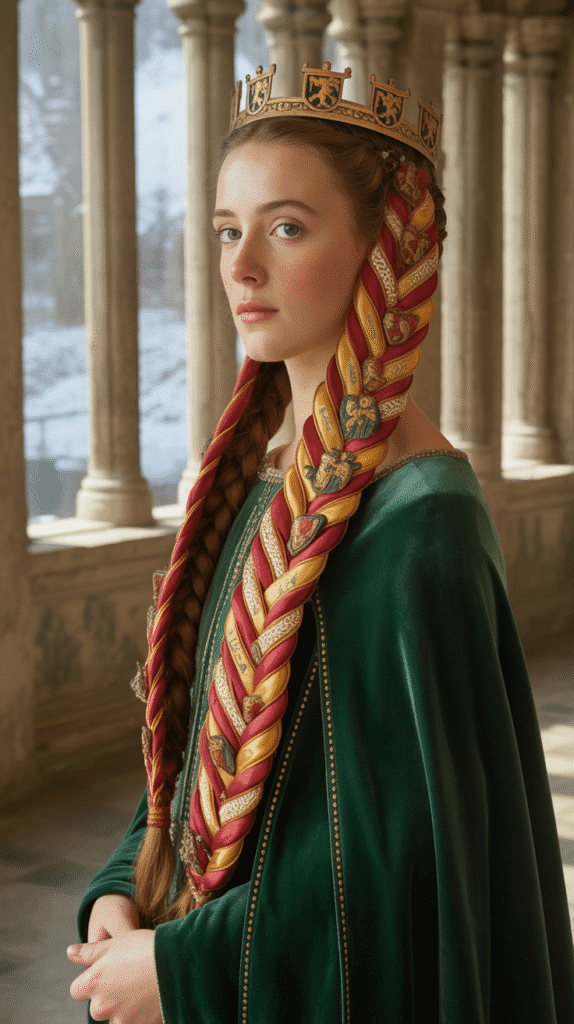
The heraldic crown braid incorporated family colors, symbols, and heraldic designs directly into the hairstyle through colored ribbons, embroidered bands, and symbolic ornaments.
This politically significant style announced lineage and allegiances without words.
Heraldic Integration:
- Hair was braided in patterns that accommodated heraldic color placement according to family blazons
- Ribbons in exact heraldic colors were woven through braids in proper proportions and arrangements
- Small embroidered patches featuring family symbols (lions, eagles, fleurs-de-lis) were sewn onto visible hair bands
- The crown itself bore family crests and coordinated with the hair’s heraldic display
- Some styles incorporated tiny shields or heraldic badges pinned into the braided structure
Political Communication:
- The hairstyle immediately identified the princess’s family and political connections to all observers
- During strategic marriages, the bride’s hair might combine heraldic elements from both families
- Changes in political alliances could be signaled through modified heraldic hairstyling
- Tournaments and state visits featured heightened attention to heraldic hair presentation
26. The Moonlight Maiden Crown
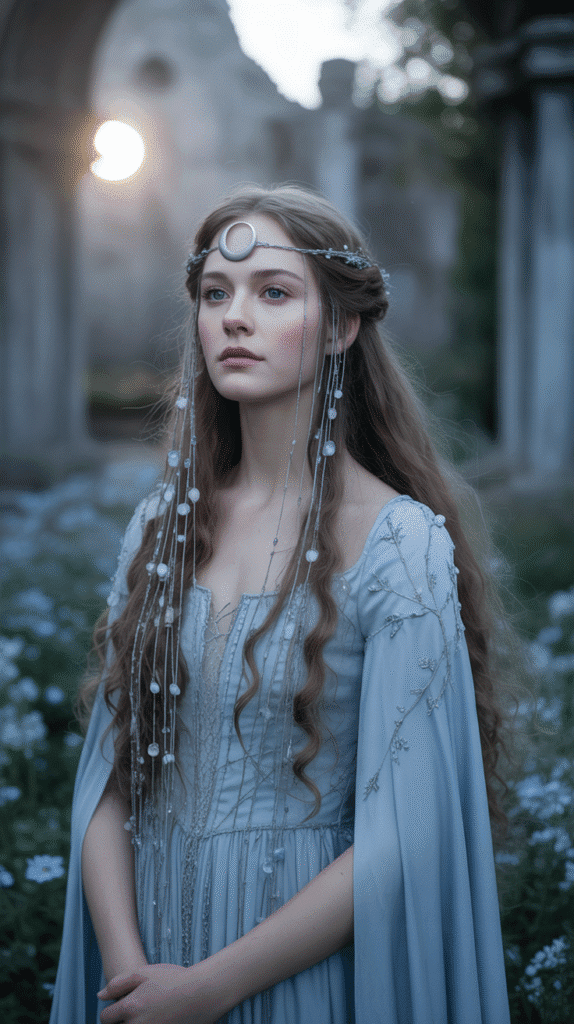
The moonlight maiden crown created an ethereal, otherworldly appearance through the use of silver elements, pale ribbons, and strategically placed crystals or moonstones that caught light like celestial bodies.
This romantic style evoked mystery and magic.
Celestial Styling Elements:
- Hair was arranged in loose, flowing styles that suggested natural rather than rigid structure
- Silver threads and pale silk ribbons in white, silver, and palest blue were woven throughout
- Clear crystals, moonstones, or polished silver beads were placed to catch candlelight and create sparkle
- The overall effect emphasized movement and light reflection rather than static structure
- Crowns or circlets featured crescent moon designs and were often made of silver rather than gold
Symbolic Associations:
- The moon represented femininity, mystery, and the divine feminine in medieval cosmology
- This style appeared at evening events, where candlelight enhanced its ethereal qualities
- Princesses known for learning, astronomy, or mystical interests particularly favored moonlight styling
- The pale color palette created striking contrast for dark-haired princesses
Occasion-Specific Usage:
- Night festivals, particularly midsummer celebrations, featured moonlight maiden styles
- Winter solstice ceremonies incorporated these cool-toned, luminous hairstyles
- Astronomical events like eclipses or comet appearances inspired courtly adoption of celestial styling
Mystical Enhancement Techniques:
- Some ladies-in-waiting used pearl powder or finely ground mica to dust hair for additional shimmer
- Certain herbs believed to have lunar associations were incorporated into the style
- The timing of hairstyling sometimes coordinated with moon phases for those who followed such traditions
27. The Victory Crown with Laurel Braids
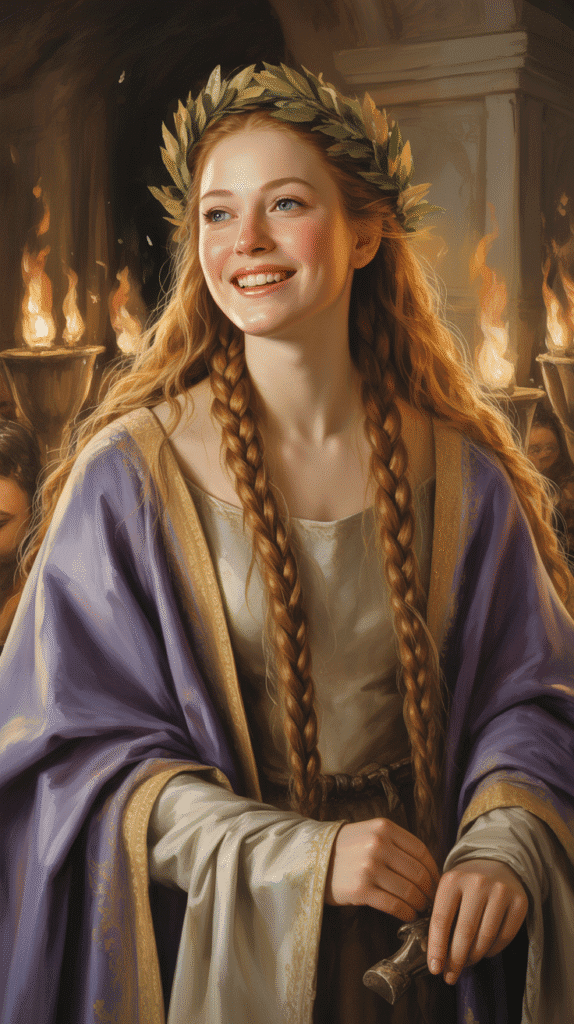
The victory crown with laurel braids drew inspiration from classical Roman traditions, featuring braids styled to resemble laurel wreaths and adorned with actual laurel leaves or gold laurel replicas.
This triumphant style celebrated victories, achievements, and martial success.
Classical Revival Elements:
- Braids were formed into circular or horseshoe shapes reminiscent of Roman laurel crowns
- Fresh laurel leaves were woven into braids when available, particularly after military victories
- Gold or silver laurel leaf replicas provided permanent alternatives to fresh foliage
- The style consciously evoked ancient imperial imagery to connect medieval royalty with Roman glory
- Crowns worn with this style often featured laurel motifs in their design
Victory Contexts:
- Princesses wore this style during celebrations of military triumphs achieved by their families
- Tournament victories by royal champions prompted ladies to adopt laurel styling
- Diplomatic successes and favorable treaty signings occasioned victory crown appearances
- Some regions incorporated the style into wedding celebrations, viewing marriage alliances as political victories
Cultural Renaissance:
- This style represented medieval engagement with classical learning and texts
- The revival of classical motifs in hairstyling paralleled similar movements in art and architecture
- Italian courts, closest to Roman heritage, most enthusiastically adopted laurel crown styles
- Northern European courts adapted the concept to include local plants like oak leaves alongside laurel
Martial Femininity:
- The style allowed princesses to participate symbolically in martial glory and dynastic strength
- Warrior queens and regents particularly favored laurel styling to emphasize their political authority
- The combination of classical military symbolism with feminine beauty created powerful visual statements
Conclusion
The magnificent tradition of 27 Royal Medieval Hairstyles for Princesses with Crowns reveals that medieval beauty was an intricate art form blending personal expression, political communication, and extraordinary craftsmanship.
These hairstyles transcended mere fashion to become powerful symbols of status, identity, and cultural values that defined an entire era.
From the architectural complexity of spiral tower braids to the ethereal beauty of moonlight maiden crowns, each style tells stories of the remarkable women who wore them and the skilled artisans who created them.
The integration of crowns, circlets, and tiaras into these elaborate hair structures demonstrated both engineering ingenuity and aesthetic brilliance that modern hairstylists continue to admire and adapt.
Whether incorporating fresh flowers, woven pearls, gold threads, or heraldic symbols, medieval princesses understood that their hair provided a canvas for displaying wealth, announcing allegiances, and expressing individual personality within rigid social hierarchies.
These timeless styles continue to inspire contemporary fashion, appearing in bridal collections, theatrical productions, and historical recreations that keep medieval beauty traditions alive.
The hours of preparation, the precious materials invested, and the symbolic meanings embedded in every braid and coil remind us that beauty has always been intertwined with culture, politics, and personal identity.
As you explore these 27 Royal Medieval Hairstyles for Princesses with Crowns, may you discover inspiration for your own creative expressions, whether recreating historical authenticity or adapting medieval elegance to modern sensibilities.
The legacy of these regal hairstyles endures as testament to human creativity, the enduring appeal of beauty, and the timeless desire to crown ourselves with glory.Retry